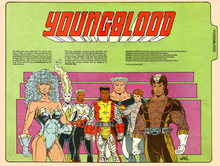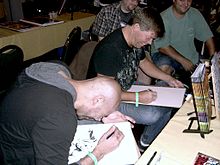Rob Liefeld
As a high-school student, he took basic fundamental art courses,[14] and attended comic book conventions at the nearby Disneyland Hotel, where he met creators such as George Pérez, John Romita Jr., Jim Shooter, Bob Layton, Mike Zeck and Marv Wolfman.
[19][20] Carlson and his colleague Chris Ecker later met with the teenaged Liefeld, who at that point had not yet obtained his driver's license, at the Ramada O'Hare Hotel, which was then the location of the Chicago ComiCon.
Impressed with the artist's enthusiasm and the new art samples he showed them, Carlson gave Liefeld a test script in order to judge his ability to draw a page-to-page comics story.
[16] Liefeld's layouts for Hawk and Dove #5, which took place in a chaos dimension, were oriented sideways so that a reader would have to turn the comic book at a right angle to read them.
Because this was done without prior editorial approval, editor Mike Carlin cut and pasted the panels into the proper order, and Karl Kesel lightboxed them onto DC comics paper to ink them.
Kesel disputed this, asserting that this was the first time that dimension had been shown, but a 2007 article in Comic Book Resources pointed out that artist Erik Larsen had indeed portrayed that realm in this manner in Doom Patrol #14, which had been published three months prior.
[14][6] Liefeld was subsequently interviewed by Stan Lee in the second episode of the 1991 documentary series The Comic Book Greats, in which he discussed how he broke into the industry, demonstrated his drawing technique, and talked about his Levi's commercial.
[36] In 1996, Liefeld's and Lee's studios signed with Marvel to re-envision several of the company's core series, an event called "Heroes Reborn".
Due to disappointing sales, Marvel terminated the agreement after six issues, and reassigned the two series to Lee's studio,[37] one of the most controversial episodes in Liefeld's career.
This new enterprise, announced in April 1997 as a partnership between Liefeld and Malibu Comics founding partner Scott Mitchell Rosenberg, concentrated its efforts on newer properties.
[66] In June 2011, he was announced as the artist on a new Hawk and Dove series, with writer Sterling Gates, as part of The New 52, DC Comics' relaunch of their entire superhero line, returning Liefeld to the characters that helped establish him in the industry.
[68] Though he indicated in July 2012 that he would stay on the titles for a run that would end in 2013,[69] he abruptly quit DC Comics in late August 2012, announcing that the #0 issues to be published in September would be his last.
[70][71] Other reasons he cited were frequent rewrites of his material, and the overall corporate culture that was more prevalent now that both DC and Marvel were owned by large media conglomerates.
[71] In response to these events, artist Pete Woods defended DC editorial, stating that the restrictions placed on creators was the result of a plan they had for all 52 of their titles that required them to be consistent with one another.
[84] Artist Dave Johnson, who had also worked on the character, referenced a video Liefeld posted on the Web a year earlier of him inking a comics page while driving,[86] by saying, "Yes!!!
Then-Marvel Editor-in-Chief Axel Alonso also referenced other creators who had worked on Deadpool, including Gerry Duggan, Brian Posehn, and Tony Moore, saying, "Welcome to the D-list, @GerryDuggan @thebrianposehn @tonymoore!
[83][84][89] Liefeld stated that his point was that "heavy contract players" at Marvel such as Leinil Francis Yu, Steve McNiven, Arthur Adams, and Olivier Coipel did not produce regular monthly books featuring the character.
Liefeld stated that his original complaint was that Marvel tended to rely on new and unproven talent on Deadpool, and not to attack creators such as the then-new team of Posehn, Duggan, and Moore.
[101] Bloodstrike features a squad of assassins, each of whom is a super-powered operative who died in the line of duty and was resurrected by a secret government program called Project Born Again.
Over the years, interest had been expressed in the property by individuals such as Akiva Goldsman and Graham King, and production companies such as Netflix, which optioned the development rights, but these eventually expired without any produced results.
[103] Liefeld explained in the caption that accompanied the trailer that he released it in the hopes of spurring renewed interest in producing a Bloodstrike film, saying, "When taking a comic book from page to screen there are always hurdles, screenplay, screenwriters, talent that attach and move on.
"[108][109] In the February 3, 2025 episode of his podcast, Robservations, and a follow-up interview with The Hollywood Reporter, Liefeld stated that he had severed ties with Marvel, following perceived slights at the July premiere in New York of Deadpool & Wolverine.
For every detractor who thinks he's the worst thing to happen to comic books since Fredric Wertham, there are a dozen ravenous fanboys ready to snatch up whatever he does next.
[113] Millar in particular wrote the foreword to the 2008 Youngblood collection published by Image Comics, in which he defended that series as an entry in the celebrity superhero subgenre that predated The Authority and X-Statix.
[117] In 2012, Rich Johnston of Bleeding Cool said of DC Comics' decision to assign Liefeld the co-scripting and drawing duties on three of their flagging New 52 titles, "Rob does have a habit, of course, of pulling out sales and attention like a rabbit out of a hat.
I didn't give him those big tits for nuthin..."[124][127] He revisited the illustration in September 2023 with a New York Comic Con variant cover for Captain America (vol 10) #1, depicting the Sam Wilson incarnation of the character in the same pose.
He also was credited as the sole creator of Youngblood, when documentation suggests that Liefeld's longtime friend and collaborator Hank Kanalz co-developed that team with him.
"[2] These remarks drew criticism from writers Dan Slott, Mark Waid, and Kurt Busiek, and artist Darick Robertson, who felt that Liefeld was diminishing Nicieza's contributions to the character.
[5][35][148] Liefeld responded to this accusation by stating that in these instances, which he said were limited to ten, he was offering tribute to the artists of the original pieces in question, rather than plagiarizing, and compared this to the work of filmmaker Brian De Palma, who used the techniques of Alfred Hitchcock.
Layton cites Deathmate, and Image's inability to produce its half of that series in a timely manner, as the first disaster that heralded the end of the speculator boom of the 1990s, and the eventual demise of Valiant Comics.





